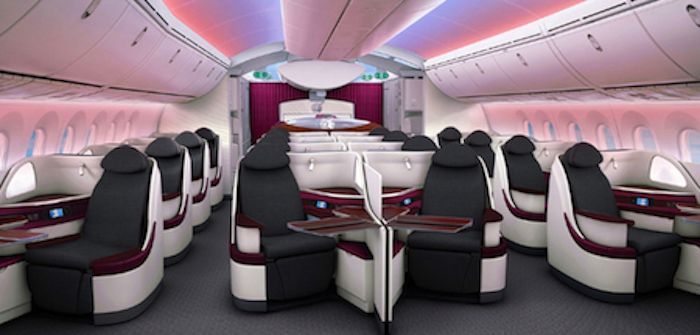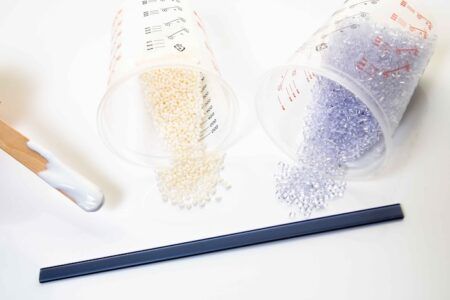When an airline as ambitious as Qatar Airways announced it was creating an interior for its new flagship aircraft, this was never going to be a tick-the-boxes catalogue option, with familiar products clad in maroon trim. Not with the indomitable CEO Akbar Al Baker charged by the Emir of Qatar himself to grow the airline from a small regional carrier into a leading international airline. And especially not with an order for 30 787-8s and an option for a further 30 giving Al Baker influence at Boeing and status as the Middle East launch customer of the aircraft.
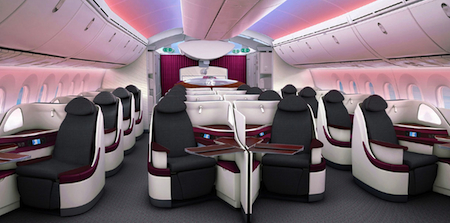
The size of the order meant that the airline had sufficient clout to divert from the catalogue options, in terms of furnishings and layout. “Qatar Airways refused the catalogue interior. Qatar’s aeroplanes will never be a compromise,” Al Baker told Aircraft Interiors International at the airline’s 787 launch. “Qatar Airways has its own identity to represent in the cabin and chose to do so by reflecting its brand values and cabin vision through the superior product selection and implementation.”
The design process began in 2007 as the initial Boeing order was made, and Paris-based Pierrejean Design Studio was consulted in the early stages to work with B/E Aerospace and Qatar Airways’ own aircraft and product development team on the interiors.
A two-class configuration was chosen because when the routes for the 787 were being selected in recession-hit 2008, it was decided that first class was not needed. Also, the airline had already configured its B777 fleet in two classes. Instead, a business class that offered an experience closer to first class was decided upon.
This aim was of course aided by Qatar’s off-catalogue approach. It was an opportunity for the airline to develop custom seat configurations and to arrange the LOPA with the lavatories and galleys configured in a different way. The design optimised the cabin area with a new seat concept and minimal dead space, while also adding new features to the front and back rows.
Welcome on board
Qatar was looking for something a little different from its neighbouring rivals such as Etihad, Emirates and Oman, so it opted for a very open feel to the business cabin. All Qatar guests board through Door 2, giving them the real ‘wow’ factor of the high ceiling after leaving the confines of the air bridge, enhanced by the 787’s large windows and the dynamic LED lighting. This is the closest relation to the original grand boarding concept developed by the Boeing Interiors Responsibility Center in 2003, and it really shows off the cabin height, especially since there is no central overhead stowage or overhead crew rest. The space was also made possible thanks to the relocation of the galleys and lavatories.
“We are the first airline to take delivery of the B787 with the dome and we have integrated this elegantly into a custom social area, which immediately creates a unique experience for our passengers while boarding and also during flight,” states Al Baker.
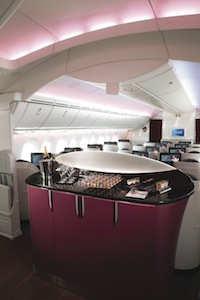 This area is key to the aircraft. Firstly, with all passengers passing through, it gives everyone a very positive first impression, even for those heading to the rear. It also helps achieve that aim of being close to a first-class experience, as the space doubles as a bar area after take-off, flanked by two marble-topped cabinets you won’t find anywhere in the Boeing catalogue. During flight, the top of one cabinet holds drinks and snacks, while the other holds magazines and items from duty free.
This area is key to the aircraft. Firstly, with all passengers passing through, it gives everyone a very positive first impression, even for those heading to the rear. It also helps achieve that aim of being close to a first-class experience, as the space doubles as a bar area after take-off, flanked by two marble-topped cabinets you won’t find anywhere in the Boeing catalogue. During flight, the top of one cabinet holds drinks and snacks, while the other holds magazines and items from duty free.
The area is luxurious, but considering its footprint could accommodate a further four seats, is it worth the potential lost revenue to Qatar? “It was important to offer passengers some sort of lounge where they can stand and have a drink and some food, and spend time with other passengers or colleagues,” explains Al Baker. “The seats are more private than standard double seats, so we needed this area where passengers can mingle.”
To avoid disturbance to passengers sitting directly forward and aft of the bar area, a partition was mounted at the rear of the monuments, with its height carefully chosen to keep an open feeling while still giving those passengers some privacy.
The design of the bar units under the dome proved to be one of the most challenging aspects of the programme. Qatar Airways wanted a unique experience for their passengers when first entering, but when Boeing presented the catalogue options for the Door 2 monuments, it was far from the look and feel desired by the airline. Hence, an off-catalogue approach was pursued, and Qatar Airways worked extensively with AIM Aviation and B/E Aerospace to develop these two units. The challenges were even greater as the aircraft had not yet been finalised; hence, 3D digital mockups were used to ensure that the seat and the monuments were properly integrated. Prototypes were made and then a full-scale design for the manufacturing workshop was created in conjunction with Boeing and the vendors, with the prototypes installed at the Seattle mockup facility. This work also led to a review of the cabin layout and precipitated the movement of the lavatories to ensure that the two passengers in the aft section of the business-class cabin would not be disturbed by the lavatory doors opening and closing.
Upwardly mobile
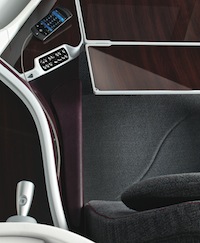 While the business-class seats are a bespoke design, their design and certification process was simplified as they use a known model as their basis: the B/E Aerospace Super Diamond reverse-herringbone seat.
While the business-class seats are a bespoke design, their design and certification process was simplified as they use a known model as their basis: the B/E Aerospace Super Diamond reverse-herringbone seat.
According to Al Baker, this company was selected as, “We believe that B/E Aerospace is one of the most experienced business-class seating suppliers in the market. Its ability to undertake a complex seating programme to meet the certification requirements on different aircraft platforms, to deliver against project milestones by ensuring appropriate levels of development and engineering support, and to deliver quality and attention to detail, while offering superior maintainability, are all factors that have given us confidence.”
The Super Diamond model was chosen as, while the shell is low enough to afford the desired feeling of space in the cabin, when seated it offers passengers sufficient privacy to give the near-first-class feel that Qatar sought.
Privacy is further enhanced by the 1-2-1 configuration, which means there is direct aisle access for all. In terms of privacy, thanks to the central divider there is no real penalty for those sitting in the centre seats; indeed, they are more likely to be left undisturbed during flight as the stowage bins are above the window seats. A pair of central seats sits alone at the rear of the business cabin behind one of the bar monuments, which offer a slightly more exclusive feel, only marred by the lavatories to each side, although as a 22-seat cabin, they will not suffer from excessive traffic.
The seats are 22in wide in upright mode, converting to 30in-wide, 80in-long fully flat beds. The extra width is aided by retractable armrests, which are also set in the lower position during boarding, both to aid access and to add to the feeling of space.
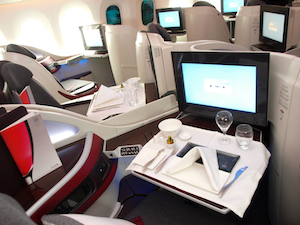
When designing the seat, the design teams were inspired by luxury German car interiors, in terms of feel and how the controls and features are arranged around the driver. The seat’s projected life of 10-12 years was also considered so it will not look outdated quickly.
The design teams also wanted to make sure the seat offered passengers a good amount of stowage, both for their personal items, and for additional items such as amenity kits. This aim was aided by the large shell the spacious 1-2-1 configuration allowed. Thus the seat has stowage compartments in the armrest and under the ottoman, as well as additional pockets for shoes, laptops and amenity kits. There is also ample overhead stowage for carry-on bags, despite the lack of central bins, as there is 141.26ft3 of capacity – enough for around 54 bags – for the 22 seats in business class.
There is also a wide folding table for enjoying meals or using laptops. A large cocktail table featuring the seat controls, and a side-table also feature, the latter being large enough to hold a laptop during meal service or if folding the table to leave the seat. Workaholics will appreciate the universal power outlet and USB port, while readers will enjoy the magazine rack and reading light.
Pale rider
The colour scheme, unsurprisingly, was also chosen to create a feeling of space as well as luxury, and was selected by Qatar Airways’ in-house design team. The open cabin design means you see a lot of the white sidewalls and the vaulted white ceiling, which, combined with the pearl white seat shells, creates a very light space, especially with the large windows letting in sunlight. A little warmth is added by the carpet’s two shades of grey, which create diamond shapes with maroon squares in the centre. This maroon is also used as an accent colour for areas such as the leather armrests and is a key colour in the palette, as it is the official colour not just of the airline, but of the Qatar flag.
The seat fabric is a textured grey broken by stitched accents and burgandy piping, which is echoed on the seatbelts, while a flash of Bordeaux cherry leather surrounds the IFE control area. The table surfaces are finished in a gloss mahogany-effect veneer edged in anodised silver.
As Al Baker explains, the whole cabin, from the architecture, to the windows, to the seat shells, all harmonise: “Together, these elements unify the cabin design and provide cohesiveness that lends the environment a collective sense of space, lightness and openness,” he explains.
Al Baker goes on to say that the airline decided against the bold patterns that one often finds in aircraft soft furnishings, saying that that look is becoming rather dated. Instead the Qatar team strived for a more residential feel, with the modern grey dress covers having a tactile weave construction, blending silver grey with black tones, and the subtle burgundy piping adding a little extra luxury.
Overall, the 787 business-class product is far superior to that found on other Qatar aircraft. That does not mean Dreamliner passengers will pay more for the privilege though, as Al Baker states, “We will not swindle passengers. We will charge the same for business class on our 787 as on our other aircraft”.
Strong economy
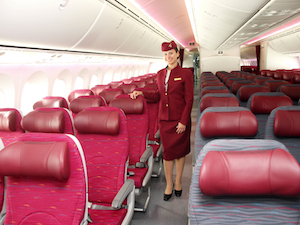
Head through the curtains (burgandy, to match the seat piping) and the economy section again has a light feel, with the 232 seats separated by a lavatory area with four cubicles, splitting it into 135 and 97 seats. There is less headroom in the economy cabin, as central overhead stowage bins are needed, which at 643.14ft3 volume can accommodate 226 bags.
The seats are arranged 3-3-3, with the outboard triples clad in burgandy fabric flecked grey and the centre triples in grey fabric flecked with burgandy. All have grey armrests and seatbelts, which are complemented by the grey carpet, and have leather headrests clad in the Qatar maroon. The IFE system is supported by ports for USB and portable device connection.
The Recaro Comfort Line 3620 seat, as launched on Qatar’s single-aisle fleet in 2009, was specified for the 787. The 16.97in width is relatively tight, but the 32in pitch seems more generous thanks to the slim, single-beam design and 7in of recline. The seat cushion design has been optimised for this aircraft, and the flexible backrest adjusts to ‘cradle’ the passenger, according to Recaro, while the adjustable ‘hammock-style’ headrest supports the head.
It is a simple economy cabin, and the only complaint one could make about comfort is that the IFE boxes found under several of the aisle seats can restrict legroom.
As Al Baker adds, “Recaro seats were chosen for the economy cabin as they were the most comfortable seats for long-haul flights. We see the Recaro 3620 seat as the benchmark for the industry in this regard – superior specifications and innovative products compared with competitors. Their product also offers commonality across our fleet, which is extremely important for us to ensure lowest cost of ownership and a consistent product for our passengers.”
Fair necessities
To the rear of the economy cabin are two more lavatories, making a total of eight, and a second, large galley. These facilities may have been relocated by Qatar, but the airline stuck with the catalogue options for their specification, with Jamco galley complexes featuring B/E Aerospace, Iacobucci and Driessen inserts, and the lavatories also from Jamco. “We of course select what we believe is best based upon performance,” states Al Baker.
The galleys are standard catalogue specification, but in the lavatories a few subtle changes were made. “We have customised many of the finishes to offer a unique experience that harmonises with Qatar Airways’ brand language and interior look and feel,” explains Al Baker.
“For example we have wooden flooring, even in the economy cabins, to ensure uniformity of design and to help exude a sense of warmth across the entire aircraft,” he adds. “The colours are very light and airy, with custom films used on the walls to add an extra touch of luxury. We have also developed a custom liquid soap holder for our passengers that has now become part of the catalogue.”
A further change made from standard specification was the mirror area in the lavatories, redesigned in conjunction with Teague so that passengers washing their faces in the sink don’t hit their heads. A nice touch is that, like the ANA 787, visitors to the business-class lavatories can enjoy the view thanks to a window. And those of an especially shy disposition will be pleased to find that the window is fitted with a conventional pull-down shutter.
Making light of problems
So what was the most challenging aspect of the project? Creating a bespoke seat shell? Creating the bar monuments? No, it was the dynamic LED system, which allows so many customisation options that it was difficult to decide on the settings. Remember the task was more difficult when it was being defined four years ago as it was a new technology – indeed had the 787 not been delayed, Qatar would have been one of the first airlines to feature LEDs. Several mood options have been specified, from a bright, welcoming light for boarding, to just the right softness for meal service, to a night setting, to settings that minimise jetlag. A ‘dome’ setting was also created to show off of the vaulted ceilings.
“We wanted to create different ambience for different parts of the service,” explains Al Baker. “The most difficult part was creating the sleeping programme because you can’t just make it dark as some passengers will want to use their computers or watch IFE.”
The hallmark of a good cabin design is often how faithful it has remained to the original brief. In the Qatar design the aim was to create something different from other airlines in the region and reflect Qatar’s five-star status. That goal has certainly been achieved.


